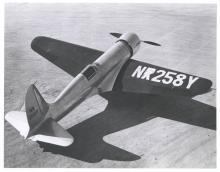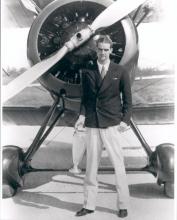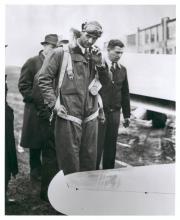Collection Paragraphs
Howard Hughes Aviator

Hughes: "It says the plane with which he set the land speed record was, as the fact indicates, the fastest plane built up to that time is not correct because there had been one or two seaplanes built for the Schneider Trophy Race which were faster. However they had practically no range and were only usable on a very very smooth lake with fuel enough for a few minutes flight, utterly impractical. This airplane [H-1 Racer] which is under discussion here was the fastest land plane which had ever been built and was the most efficient airplane ever built up to that time by a considerable amount... You see this airplane was fast because it was clean and yet it attained its speed with a Pratt and Whitney engine of perfectly normal design with normal reliability.

Now this follows - Hughes submitted a pursuit plane version of his design to the Army Air Corps and felt confident that after his demonstration of his trans-continental flight the army would be interested because this airplane was definitely faster than any military aircraft anywhere in the world - pursuit plane, bomber, or anything else... However the Army Air Corps did not accept this design. Right here I don't know exactly what reason to give. I don't want to indict the Army Air Corps for passing up the airplane so a little thought should be given to this. I have my own ideas as to why they didn't accept it but after all I'm doing a lot of business now with the Air Force and let's not generate any ill-will here.
Now regarding the Japanese Zero... The Japanese Zero was a shock of the utmost magnitude to the United States because it had been thought up to that time that the Japanese were far inferior mechanically, I should say in point of aircraft design and mechanical aptitude, to the United States and nobody expected the Japanese to have an airplane that would be at all competitive. Well, in any event, when one of these Japanese Zeros was finally captured and studied and analyzed it was quite apparent to everyone that it had been copied from the Hughes plane which has been discussed earlier here. That is the only relationship between the Japanese Zero and the Hughes H-I design. I had no dealings with the Japanese or any other foreign government for the plane and to the best of everyone's knowledge the Japanese had no other access to it except through whatever espionage they may have had or through seeing photographs of it which naturally were published all over the world.

Bill Utley: (attending the meeting as the Hughes company publicist, recounts how before the war a delegation of Japanese air force generals had seen the H-1 in a hangar in New Jersey) "They were late for a banquet in New York where they were being toasted and they saw your airplane and I have been told by Al Ludwick I think, that they couldn't drag them away from it, that they climbed all over it, that they examined it from head to toe, and that was the start of their interest in your airplane"
Hughes: Oh, really?
Utley: Yeah.
Hughes: Well, I don't think we better bring that in because there might be some question as to why the hell they were let in the hangar.
Utley: They had been invited here by the United States Government
Hughes: I know, but you can't explain all those things without going into too much detail
...There were photographs all over the place and I don't think the Japanese would have to see it to copy it - they could copy it from the pictures.
